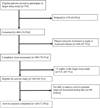Daytime Physical Activity and Sleep in Hospitalized Older Adults: Association with Demographic Characteristics and Disease Severity
- PMID: 26131982
- PMCID: PMC4752005
- DOI: 10.1111/jgs.13520
Daytime Physical Activity and Sleep in Hospitalized Older Adults: Association with Demographic Characteristics and Disease Severity
Abstract
Objectives: To assess objectively measured daytime physical activity and sleep duration and efficiency in hospitalized older adults and explore associations with demographic characteristics and disease severity.
Design: Prospective cohort study.
Setting: University of Chicago Medical Center general medicine wards.
Participants: Community-dwelling inpatients aged 50 and older (N = 120) MEASUREMENTS: Physical activity and sleep were measured using wrist accelerometers. Information on Charlson Comorbidity Index and length of stay was collected from charts. Random-effects linear regression analysis was used to examine the association between in-hospital sleep and physical activity.
Results: From March 2010 to May 2013, 120 participants wore wrist actigraphy monitors for at least 2 nights and 1 intervening day. Median activity level over the waking period was 77 counts/min (interquartile range 51-121 counts/min), an activity level that approximately corresponds to sitting while watching television (65 counts/min). Mean sleep duration the night before the activity interval was 289 ± 157 minutes, and mean sleep efficiency the night before the activity interval was 65.2 ± 26.9%. Mean activity counts/min were lowest for the oldest participants (oldest quartile 62, 95% confidence interval (CI) = 50-75; youngest quartile 121, 95% CI = 98-145, trend test P < .001) and those with highest Charlson Comorbidity Index (highest tertile 71, 95% CI = 60-83; lowest tertile 125, 95% CI = 104-147, trend test P = .01). Controlling for severity of illness and demographic characteristics, activity declined by 3 counts/min (95% CI = -5.65 to -0.43, P = .02) for each additional hour of inpatient sleep.
Conclusion: Older, sicker adults are less physically active during hospitalization. In contrast to studies in the community, inpatients who slept more were not more active. This may highlight that need for sleep is greater in the hospital than in the community.
Keywords: low mobility; older hospitalized adults; physical activity; sleep.
© 2015, Copyright the Authors Journal compilation © 2015, The American Geriatrics Society.
Conflict of interest statement
Figures
Similar articles
-
Association between objectively measured sleep quality and physical function among community-dwelling oldest old Japanese: A cross-sectional study.Geriatr Gerontol Int. 2015 Aug;15(8):1040-8. doi: 10.1111/ggi.12396. Epub 2014 Oct 14. Geriatr Gerontol Int. 2015. PMID: 25312049
-
Association Between Sleep and Physical Function in Older Veterans in an Adult Day Healthcare Program.J Am Geriatr Soc. 2015 Aug;63(8):1622-7. doi: 10.1111/jgs.13527. Epub 2015 Jul 22. J Am Geriatr Soc. 2015. PMID: 26200520 Free PMC article. Clinical Trial.
-
Objective Sleep Characteristics and Factors Associated With Sleep Duration and Waking During Pediatric Hospitalization.JAMA Netw Open. 2021 Apr 1;4(4):e213924. doi: 10.1001/jamanetworkopen.2021.3924. JAMA Netw Open. 2021. PMID: 33792731 Free PMC article.
-
Sleep Assessment in Large Cohort Studies with High-Resolution Accelerometers.Sleep Med Clin. 2016 Dec;11(4):469-488. doi: 10.1016/j.jsmc.2016.08.006. Epub 2016 Oct 27. Sleep Med Clin. 2016. PMID: 28118871 Review.
-
Sleep in Hospitalized Older Adults.Sleep Med Clin. 2018 Mar;13(1):127-135. doi: 10.1016/j.jsmc.2017.09.012. Epub 2017 Nov 10. Sleep Med Clin. 2018. PMID: 29412979 Free PMC article. Review.
Cited by
-
The association of sleep quality, delirium, and sedation status with daily participation in physical therapy in the ICU.Crit Care. 2016 Aug 18;19:261. doi: 10.1186/s13054-016-1433-z. Crit Care. 2016. PMID: 27538536 Free PMC article.
-
Day-Night Activity in Hospitalized Children after Major Surgery: An Analysis of 2271 Hospital Days.J Pediatr. 2019 Jun;209:190-197.e1. doi: 10.1016/j.jpeds.2019.01.054. Epub 2019 Mar 15. J Pediatr. 2019. PMID: 30885646 Free PMC article.
-
Use of actigraphy to characterize inactivity and activity in patients in a medical ICU.Heart Lung. 2020 Jul-Aug;49(4):398-406. doi: 10.1016/j.hrtlng.2020.02.002. Epub 2020 Feb 24. Heart Lung. 2020. PMID: 32107065 Free PMC article.
-
Preoperative risk factors of malnutrition for cardiac surgery patients.Acta Med Litu. 2016;23(2):99-109. doi: 10.6001/actamedica.v23i2.3326. Acta Med Litu. 2016. PMID: 28356796 Free PMC article.
-
Nutritional Status and Post-Cardiac Surgery Outcomes: An Updated Review with Emphasis on Cognitive Function.J Clin Med. 2024 Jul 9;13(14):4015. doi: 10.3390/jcm13144015. J Clin Med. 2024. PMID: 39064055 Free PMC article. Review.
References
-
- Brown CJ, Redden DT, Flood KL, et al. The underrecognized epidemic of low mobility during hospitalization of older adults. J Am Geriatr Soc. 2009;57:1660–1665. - PubMed
-
- Callen BL, Mahoney JE, Grieves CB, et al. Frequency of hallway ambulation by hospitalized older adults on medical units of an academic hospital. Geriatr Nurs. 2004;25:212–217. - PubMed
-
- So C, Pierluissi E. Attitudes and expectations regarding exercise in the hospital of hospitalized older adults: A qualitative study. J Am Geriatr Soc. 2012;60:713–718. - PubMed
-
- King BD. Functional decline in hospitalized elders. Medsurg Nurs. 2006;15:265–271. - PubMed
Publication types
MeSH terms
Grants and funding
LinkOut - more resources
Full Text Sources
Other Literature Sources
Medical


